Making homemade Sauerkraut is easier than you think! Full of healthy probiotics that support our gut and boost our immune system, sauerkraut is fermented cabbage that takes under 15 minutes of hands-on time before mother nature takes over!
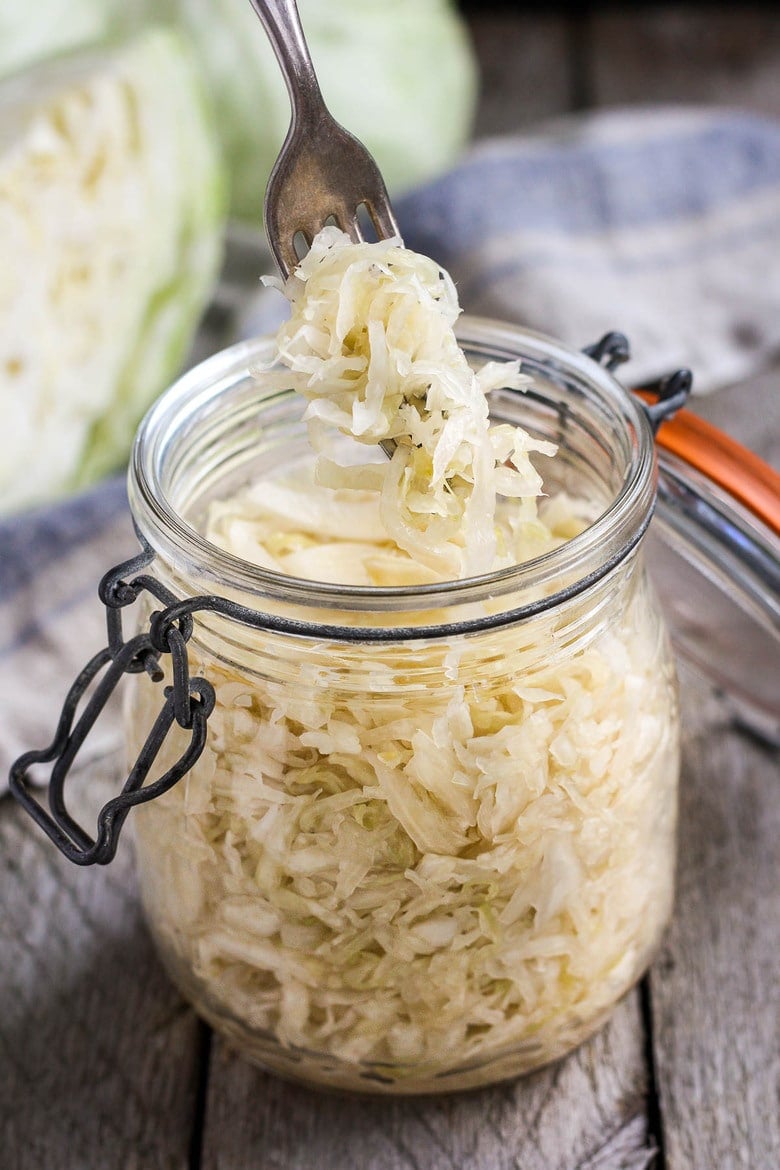 Gratitude can turn a meal into a feast, a house into a home, a stranger into a friend. – Melody Beattie
Gratitude can turn a meal into a feast, a house into a home, a stranger into a friend. – Melody Beattie
Cabbage and sea salt. Time does the magic here. Once you introduce sauerkraut into your diet, your body may just start asking for more. Eating fermented foods like sauerkraut or kimchi feels so clean and alive. It is one of the richest sources of live probiotics, a tablespoon or two provides more benefits than a probiotic pill or powder! Talk about economical!
As a chef and after decades of fermenting foods, I’ve come to love the process of making sauerkraut! I love being able to et creative with flavors and control the taste. My family prefers a “less sour” sauerkraut. Tasting it as it ferments lets you find your own perfect sweet spot of flavor and texture. People who say they don’t like sauerkraut often tolerate homemade and even start to acquire a taste for it. My son, who currently likes about 2 vegetables, will eat this at almost every meal- thank goodness!
But First, What is sauerkraut?
Sauerkraut is shredded cabbage that has been cultured or allowed to ferment over time with the use of salt. The specific salt amount is crucial to a healthy fermentation. As it ferments, it gets more sour and tangy, a byproduct of the healthy living bacteria.
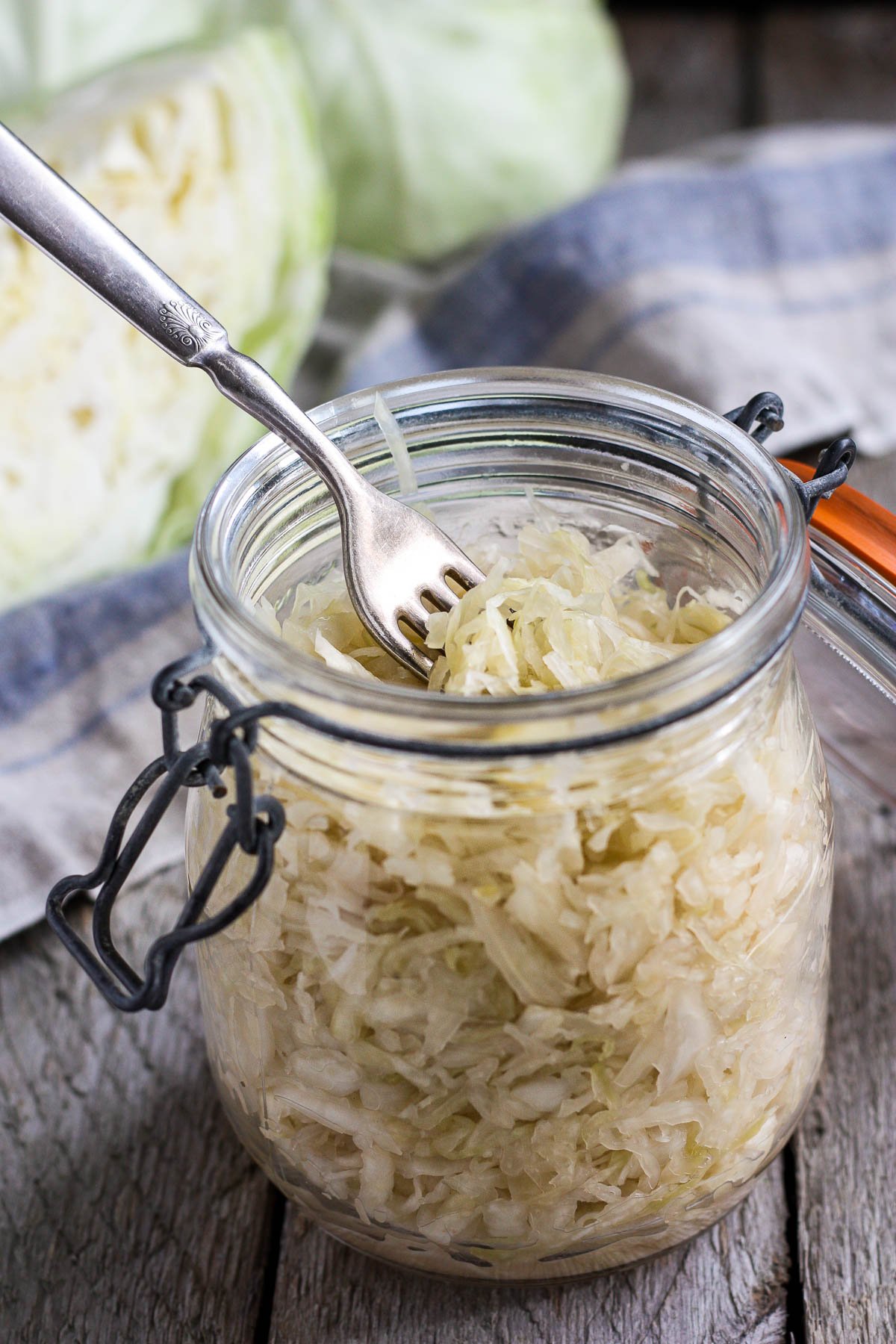
Everything you’ll need to make Homemade Sauerkraut
- Cabbage- typically made with green cabbage but really any color or type of cabbage will work!
- Sea Salt- Using a good clean salt without additives is important. Refined salt (including iodized and kosher pickling salt) with added iodine could hinder the fermenting process and cause unpleasant discoloring and undesirable texture. A good mineral-rich salt works best for fermenting. Salts high in minerals usually have a pink hue. Finely ground salt incorporates faster, helping the cabbage release juice more quickly which creates more brine and ensures a healthy ferment.
- Large bowl
- Clean Jars
- Fermentation weights
- Optional: air locks (a device that allows gases to escape the jar while preventing air from coming in)
How to Make SauerKraut
Step one: Start with clean and sanitized tools, containers and work surfaces. Set 2 cabbage leaves aside, and shred the rest with a sharp knife or mandolin. Weight the cabbage in grams. Multiply the weight of the cabbage in grams by .02. This is the amount of salt in grams, that you will need.
Massage cabbage with the salt in a bowl. Massaging the cabbage breaks down the cell walls, releasing the juices and incorporating the salt through the entire batch. If there is not a lot of brine, let it sit for a half-hour and check it. Once you start packing the cabbage into the jars it should be quite juicy.
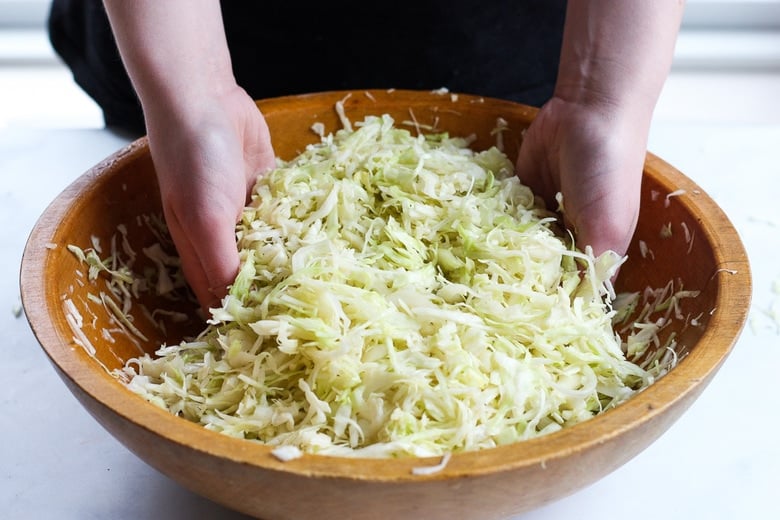
Step two: Pack in the jar. Transfer to a clean jar and pack tightly with a tamper, muddler, or your fist. If your cabbage is dry without much brine, you can create more brine by mixing 1 cup water with 1 1/2 teaspoons salt. Then add as needed to the jar.
Leave 3 inches of space between the brine level and the top of jar. Top with one or two cabbage leaves to keep shreds from floating above the brine. Keep cabbage below the brine, using a weight. This is an important key to good kraut health! This is your mantra “under the brine everything is fine.”
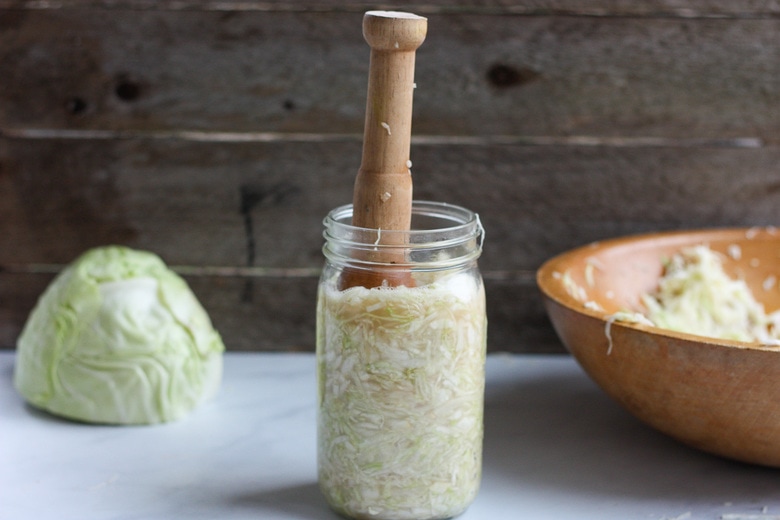
Step three: Weigh it down. Use a fermentation weight, or another clean, smaller jar that fits inside this jar to weigh the kraut down. Even a shot glass will work.
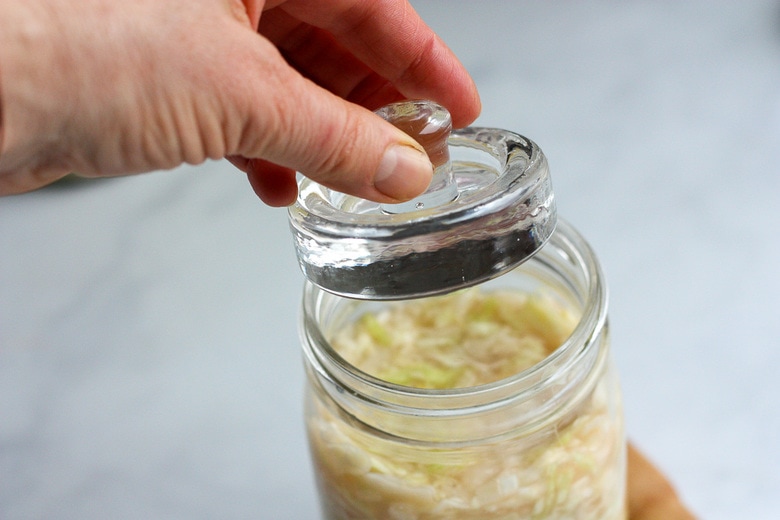
Step four: Ferment! Let this ferment out of direct sunlight and ideally where room temperature is a cool 64-72 degrees. A dark corner on your kitchen counter is good.
Step five: Check progress daily, making sure cabbage is still submerged and taste for tangy sourness starting day 3. It all depends on the climate, humidity and how sour you prefer the finished kraut to taste. 3-7 days seems to be when I get the results I like. Closer to 3 days in the summer, and more like 7 days in the winter. For really sour-tasting kraut, go 2-3 weeks. The larger your vessel, the longer the ferment.
Step six: Store! Once the sauerkraut is sour enough to your taste, remove weights and cabbage leaves and any oxidized kraut from the top, and store it in the refrigerator with a sealed lid where it will still slowly ferment. I think it tastes best after a week or two in the fridge.
How do I know when the sauerkraut is fermented?
- looks lighter and more yellow in color and slightly translucent, similar to a cooked vegetable
- smells pleasantly sour
- the texture will be firm, crunchy and not slimy
- the taste will have a tangy pickled flavor
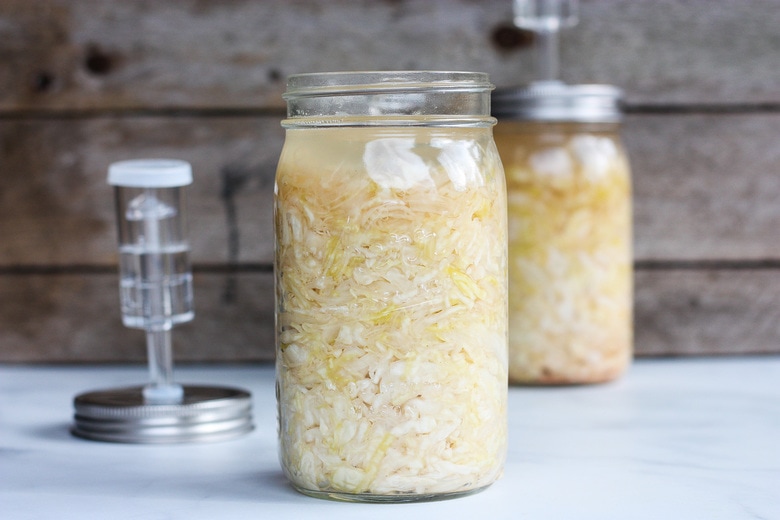
Sauerkraut Recipe Variations
Feel free to add flavorings to the kraut- caraway seeds, fresh ginger, fresh turmeric, onion, garlic cloves, dill or dill seeds, cumin seeds, etc. Take a peek at our Beet and Cabbage Sauerkraut and our Turmeric Kraut. You can also add grated carrots.
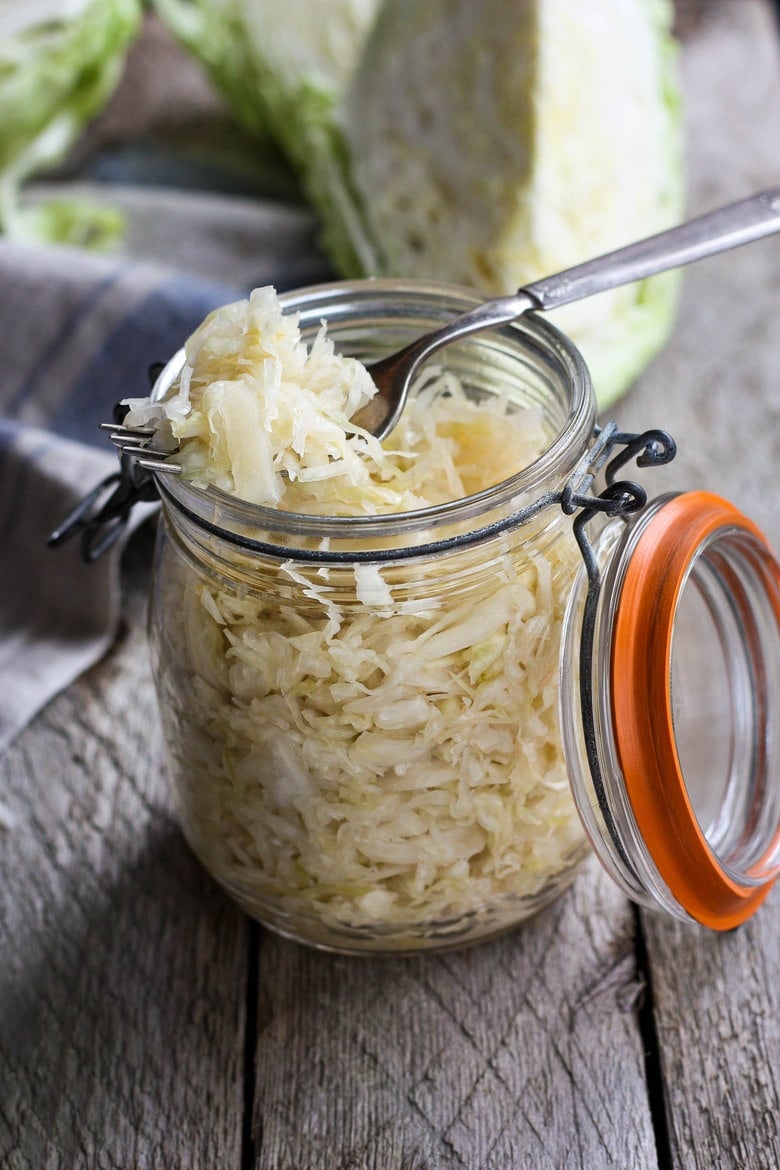
How to Store Fermented Cabbage
Once fermented, store the sauerkraut in the refrigerator, with a sealed lid where it will continue to ferment slowly. If kept below the brine, it will keep indefinitely.
Can you freeze sauerkraut?
Yes, you can freeze it but it may damage some or all of the healthy probiotics in the brine.
Ways to use Sauerkraut
Serve sauerkraut as a side dish to cut the richness of meaty dishes- roasts, stews, meaty sandwiches ( try out Tempeh Reuben), burgers, or hot dogs. Add to bowls, salads and wraps! Anything that needs a crunchy texture or a tangy component will work here!
Tips For Making Sauerkraut
Salt Ratio
Salts have different densities and weights. The recommended salinity for Sauerkraut is 1.5% – to 2.5% salt to the weight of the cabbage. Here we use 2% salt to the weight of the cabbage. Example: 1000 grams cabbage multiplied x .02= 2o grams of salt. Feel free to use more or less as long as it stays between 1.5% and 2.5%. I use Himalayan Sea Salt and Real Salt. Both are natural and unrefined with high mineral content. Once you are familiar with sauerkraut making, you will be able to add salt to taste. Tasting as you go gives you the best control over the quantity of salt. It is the simplest way to ensure success.
Benefits of using Airlocks
An airlock (below, left) is a device used in fermenting that allows carbon dioxide to escape the jar, while preventing air to enter the jar, thus avoiding oxidation.
I have fermented for many years without using airlocks. It is super easy yet I can’t say all my ferments have been successful. Since I decided to give airlocks a try, fermenting has become more foolproof with even less hands-on time.
Our goal is to cultivate friendly bacteria which thrive best in anaerobic environments. As the sugars and starches in the cabbage (or other fermenting specimens) begin to break down, an airlock allows the carbon dioxide to escape and flow out of the ferment but not back in. Keeping oxygen out means less contaminants and less potential for unwanted bacteria.
I have had great success with this Fermentation Kit that has crystal weights that fit perfectly in a wide-mouth mason jar. It is so convenient for small-batch ferments. This fermentation kit includes the jars which is a great option too!
The Benefits of This Sauerkraut Recipe
The probiotics in fermented foods like sauerkraut have been associated with a variety of health benefits, including bolstering immunity, improving digestion,and even supporting weight loss! Here are the most noteworthy:
- Increases the nutritional content of the foods being fermented.
- Supports the intestinal tract.
- Provides enzymes that aid in digestion.
- Stimulates and supports the immune system.
- May inhibit the growth of cancer cells.
- Antioxidant, anti-microbial, and antifungal
- Helps with inflammation
- Fermenting foods may increase the air quality in your home by introducing more healthy bacteria in your environment.
Watch How to Make This Sauerkraut Recipe
This sauerkraut makes it to our dinner table most nights, giving a delicious tang and crunch to many dishes. Try a dollop in soups, stews, salads, sandwiches, tacos, buddha bowls, and more! It truly elevates the meal with the added benefit of many amazing nutrients. Give it try and let us know what you think!
More Fermentation Recipes you may like:
- Curtido- Cultured Salvadoran Slaw
- How to Make Kimchi!
- Beet and Cabbage Sauerkraut
- How to make Turmeric Sauerkraut
- Fermented Hot Sauce -Simple and Delicious!
- How to make Fermented Pickles!
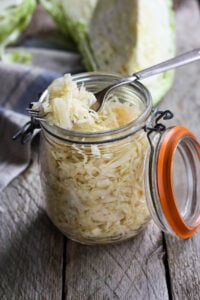
Homemade Sauerkraut
- Prep Time: 30 minutes
- Total Time: 30 minutes
- Yield: 1-2 Jars
- Category: fermented, preserved
- Method: fermented
- Cuisine: American
- Diet: Vegan
Description
Making homemade Sauerkraut is easier than you think! Full of healthy probiotics that support our gut and boost our immune system, sauerkraut is fermented cabbage that takes under 30 minutes of hands-on time before mother nature takes over!
Ingredients
- 1–2 heads of cabbage, about 2 pounds (1000 grams)
- Mineral or sea salt (not iodized)- ( 20 grams based on 1000 grams of cabbage). Or multiply .02 x the grams of cabbage, see notes)
Equiptment: 1-2 mason jars, fermentation weight, and a mudler
Instructions
- Set aside 2 cabbage leaves and leave them whole.
- Shred the remaining cabbage finely with a sharp knife or mandolin. Weigh the cabbage in grams (careful not to include the bowl’s weight). Take this number and multiply it by .02. This is the number in grams of salt you will need, so measure this out.
- Massage the measured salt into the cabbage. (Let sit 30 minutes, or longer if needed to extract more juices).
- Transfer cabbage and brine to your vessel and pack tightly with a tamper, or a muddler.
- Leave 3 inches of space between brine level and the top of the jar. Top with one or two cabbage leaves to keep shreds from floating above the brine add a fermentation weight.
- Keep the jars at room temperature (65-72F is ideal). Check progress daily making sure cabbage is still submerged ( pushing it down if not) and taste for doneness starting day 3. It will generally take anywhere from 3-5 days and will get sourer as it ferments.
- You will know that it is adequately fermented when it looks lighter in color, with a pleasantly tangy flavor.
- Store in the refrigerator with a sealed lid. To create a bubbly kraut, burping on occasion.
Notes
Salt Ratio: The recommended salinity for Sauerkraut is 1.5% – to 2.5% salt to the weight of the cabbage. Here we use 2% salt to the weight of the cabbage. Example: 1ooo grams cabbage multiplied x .02= 2o grams of salt. Feel free to use more or less as long as it stays between 1.5% and 2.5%. I use Himalayan Sea Salt and Real Salt. Both are natural and unrefined with high mineral content.
How to store: Cold temperatures (refrigeration or a root cellar if you are so lucky!) slow down the fermentation process. Make sure you store your kraut in its brine, and it will keep for at least 6 months.
Flavors: Feel free to add flavorings to the kraut- caraway seeds, fresh ginger, fresh turmeric, onion, garlic cloves, dill or dill seeds, etc.
Nutrition
- Serving Size: 2 tablespoons
- Calories: 35
- Sugar: 4.3 g
- Sodium: 728.3 mg
- Fat: 0.2 g
- Saturated Fat: 0 g
- Carbohydrates: 8.4 g
- Fiber: 2.4 g
- Protein: 1.6 g
- Cholesterol: 0 mg






Hi Tonia, thanks for sharing. I’ve made a handful of batches following your recipe but I let it ferment for 10 days before storing it in the fridge. I’ve noticed over the 10 days that the amount of liquid decreases significantly. Would you recommend topping the jar up with a salt water brine ever few days or so to keep the cabbage fully submerged throughout? Second question, is Baja gold sea salt good to use instead of Himalayan? Thanks
I think adding brine to it would be good. I have not tried Baja gold sea salt but it looks good- should be fine!
Would it be safe or hinder the process to change to a new jar for storage?
Totally fine to switch jars Rick.
Love Homemade Sauerkraut but unfortunately my doctor says I should stay off salt as much as possible. By any chance can I get the same flavor with less salt and adding some vinegar?
Hi Mino- the salt here is not just for flavor, it is for preserving and fermenting. So for this recipe, I would not alter the salt. You could make pickled a version, but not fermented? Maybe google pickled sauerkraut?
Mino, following this recipe creates a 2% brine solution. But you aren’t drinking the brine, just fishing the sauerkraut out to the solution to eat. So you are not ingesting all of the salt required in the recipe. Ask your Doctor about this recipe. I’m sure he’s happy with your increased probiotic intake.
Hello, Im making this today but Im unsure if I should put the jar into the fridge immediately after prepping or how I should properly store it while it ferments & when it should it actually go into the fridge. Thank you!
Hi Debbie, see step 5 in the recipe card. You’ll need to leave it out in a cool place (not refrigerated) for 3-5 days (or longer) to start the fermentation.
Hi Debbie, Leave it at room temperature while it ferments. It varies on when it is ready to store in the fridge, depending on your taste preference, the temperature of your kitchen etc. There are more details in the recipe card.
Hey there! Once the kraut is ready and it goes in the fridge do the jars need to be vaccume sealed? And how long should they last if they were or werent vaccume sealed once fermentation is conplete.
Thanks!
Hi Catherine, I haven’t ever tryed vacuuming sealing the kraut. It lasts 3 months or longer under refrigeration without sealing.
Great! Thanks
Also, I didnt seem to leave enough head space during fermentation and they lost some brine. What percent salt to water should I do for a brine to top off the jars?
Hi Catherine! Add 1 ½ teaspoons salt to 1 cup water.